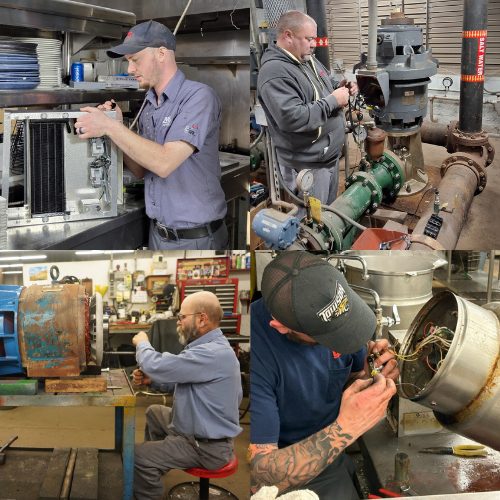Fire Prevention: Technical Kitchen Hoods 101
Josh Perkins, HVAC/R Service Manager
Fires in U.S. eating and drinking establishments cause hundreds of injuries, multiple deaths and lead to an average of $246 million in direct property damage per year, according to the National Fire Protection Association (NFPA). It is important to understand the tools available to full-service kitchen managers and chefs to help avoid and mitigate the kitchen fires.
Let’s take a look under the hood of several top technical kitchen hood systems to understand how they add a layer of protection and peace of mind for full-service kitchen managers.
Water Wash Hood Systems
In the event of a fire, the Water Wash Hood System is activated and provides internal fire protection, to keep the fire from spreading into the ductwork or other parts of the restaurant’s kitchen. These hoods are equipped with spray nozzles to spray hot water and detergent on the interior walls of the hood duct. Typically, the systems are connected to a timer that activates a wash cycle one to three times daily to proactively clean and protect the hood duct. The wash systems are tied into the restaurant’s fire suppression system. The NFPA requires water wash hood systems to be tested every six months by a qualified technician.
As a technician that installs, repairs and services technical hoods for a living, the most common wear and tear item I come across on these hoods is the detergent pump. Often times the customer will run out of detergent, which creates an empty, or dry, pump and ultimately causes a stop in the flow of detergent due to air buildup in the line. Over time this will cause damage to the pump, which will then need to be replaced. This repair is common and parts can run upwards of $200 plus labor.
Benefits of water wash systems
- Reduced risk of fire spreading throughout the restaurant
- Reduced labor costs associated with hood cleanings
- Designed specifically for the application
Ultraviolet Pollution Control Systems
Ultraviolet Pollution Control Systems are often required in kitchens based on government policies and local codes. They are used to reduce grease in an oven’s ductwork and remove odor. These systems are found in applications where there is a long ductwork run, or when the exhausted air is in close proximity to restaurant guests or high-rise residents as well as in government buildings, hospitals, and hotels.
Ultraviolet Pollution Control Systems feature indicator lights to easily identify equipment malfunctions. Statewide health departments closely monitor these systems and will issue citations if there are lamp failures. System manufacturers and service technicians alike recommended changing the lights every 8,000 hours – roughly once a year. Ultraviolet lights cost between $100 – $150. In addition, it is recommended the ballasts be changed once a year. They cost similarly to new lamps. The number of lamps used in each system varies based on the model, but some systems may have 12 ultraviolet cartridges with six lights per cartridge in the main kitchen. In this case, new lights will cost approximately $21,600 in material plus installation labor.
Benefits of Ultraviolet Pollution Control Systems
- Reduces risk of fire spreading throughout an entire building via its ductwork
- Reduces hood cleaning costs
- Reduces odor of exhausted air
- Kills mold, mildew, fungi, and bacteria
Quencher Systems
Quencher Systems are fire suppression systems that are tied to the restaurant’s sprinkler system. These systems feature water pipes with nozzles spread across the top of the cooking equipment under the hood – similar to a wet chemical system, like Ansul®. The nozzles create a fine mist to suffocate the fire. Water within the system will continue to flow until someone turns off the water supply manually. In contrast, wet chemical systems only release the amount of wet chemical that is stored in the container. At this point, fire suppression at the cooking equipment stops.
Production of Quencher Systems ceased in the late 90s, but there are still many systems in use. Parts are still available today but can be costly. Similar to Water Wash Hood Systems, certified technicians must test Quencher Systems every six months.
Benefits of Quencher Systems
- An endless supply of water that can be used to suppress the fire
- Clean up is simple and quick as the suppression agent is water
Demand Ventilation Controls
Demand Ventilation Controls are systems that have heat and smoke sensors located inside the ductwork to activate the exhaust fan when it is needed. These systems also feature carbon dioxide (CO2) sensors that will trigger more fresh air when CO2 levels are too high, when it senses smoke or heat, or if there is a high volume of people present. While there are no mandated requirements for inspections, it is recommended to have preventative maintenance performed at least every six months by a trained technician.
Benefits of Demand Ventilation Controls
- Reduced energy costs
- Automated air balancing in multi-hood applications
It is possible to have a Water Wash Hood with Ultraviolet Pollution Control with Demand Ventilation Controls, which would be a premium hood system. Every technical hood serves a different purpose and is designed for specific applications. It is key to understand your current and future needs as well as local regulations before purchasing any hood system.




